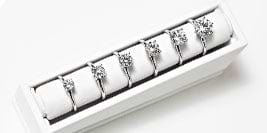CVD (Chemical Vapor Deposition) and HPHT (High Pressure High Temperature) are two distinct techniques for creating lab-grown diamonds. They differ in their processes and the conditions under which diamonds are formed, but both produce diamonds that are physically, chemically, and optically identical to natural diamonds.
As lab-created diamonds gain attention from the masses and consumers have become increasingly conscious of the environmental and ethical implications of their diamond purchases, this has given rise to a fascinating new debate. What's the difference between a stone created via CVD and HPHT?
In this article, we will compare CVD diamonds and HPHT diamonds and provide you with the information you need to know before making a purchase that you will treasure and value for years to come.
CVD vs. HPHT Diamonds: Distinguishing Lab-Grown Diamond Techniques
Comparing CVD diamonds and HPHT diamonds is an essential discussion in the realm of lab-grown diamonds, as both use different techniques.
CVD diamonds are crafted through a process where carbon molecules are deposited onto a carbon substrate, forming a diamond crystal over time. CVD diamonds often exhibit exceptional purity but tend to be less expensive than HPHT diamonds.
HPHT diamonds are formed by subjecting carbon to extreme pressure and high temperatures, which replicates the natural conditions as to how diamonds are formed in nature. With that higher price point, HPHT diamonds are also renowned for their impressive color enhancement techniques, making them ideal for use in jewelry.
Both methods yield high-quality lab-grown diamonds that are chemically, optically, and physically identical to natural diamonds.
The Lab-Grown Diamond Formation Process Explained
Lab-grown diamonds are true marvels of scientific innovation and are created under highly controlled conditions. The demand for these stones has significantly increased in recent years as younger and eco-conscious diamond consumers want to make a purchase that is ethical, moral, and rooted in sustainability.
That's where lab-grown diamonds are amazing! A jewelry shopper can purchase a diamond and feel confident that the natural environment was not impacted, no human rights abuses were experienced, and sustainable business practices were honored.
Keep reading to learn more about the process that goes into forming both CVD diamonds and HPHT diamonds.
What is a CVD Diamond?
A Chemical Vapor Disposition diamond is a type of lab-grown diamond that is produced via a cutting-edge scientific process. In its formation, a small slice of natural or synthetic diamond, what's known as a seed, is placed in a controlled chamber. The chamber is then filled with a gas mixture, usually hydrogen and methane. Then, under specific low temperatures and low-pressure conditions, the gasses are ionized into carbon and hydrogen ions. The carbon atoms then precipitate onto the diamond seed, layer by layer, forming a crystal structure identical to that of a naturally occurring diamond.
CVD diamonds have a wide range of applications, including jewelry, industrial tools, and advanced technological components.
CVD Technology… The Science from the Stars?
An interesting point to make as it relates to CVD diamonds is that the technology behind the manufacturing process is rooted in the theoretical framework of how we believe diamonds are formed in space.
Yes… outer space!
Ultimately, carbon atoms are thought to exist in abundance in space, and the process by which they come together to form diamond crystals is believed to occur in certain types of stars as well as some interstellar environments where planets are forming (i.e., protoplanetary disks). From an astronomical context, these space diamonds are larger than anything created on Earth, but the process is ultimately similar.
What is an HPHT Diamond?
(Above: a raw earth-mined, "natural" diamond versus a raw HPHT diamond)
High-Pressure High-Temperature diamonds are also created in a lab through a sophisticated process.
In the HPHT method, a tiny diamond seed (which once again can be natural or synthetic) is exposed to extremely high temperatures (up to 2,200 degrees Celsius!) and high pressure (1.5 million pounds per square inch!). Then, under these intense conditions, carbon atoms with a medium, usually a metal solvent or graphite, dissolve and recrystallize onto the diamond seed, which gradually builds up a crystal lattice structure, resulting in a diamond.
HPHT Technology… The Science from the Earth?
If CVD diamonds come from the stars, then an HPHT diamond is created based on the scientific principles of Earth.
The HPHT method mimics and replicates the natural conditions under which diamonds form deep within the Earth's mantle. In nature, the process takes a considerable amount of time and is thought to occur at depths of 150 to 200 kilometers below the Earth's surface, where temperatures are exceedingly hot, and the pressure can reach up to 725,000 pounds per square inch.
Of course, from a scientific standpoint, it's important to point out that how diamonds form in the Earth's mantle is not exact, as other processes might also be involved. However, HPHT is the most widely accepted theory for how diamonds occur in nature.
And let us throw a fun fact as we wrap up the Earth Science part of this lesson.
Contrary to popular belief, diamonds on Earth did not form recently but were created one to three billion years ago, during a period of intense volcanic activity and high heat and pressure in Earth's mantle. The diamonds that are mined today have existed for billions of years…but they didn't take billions of years to form, just like lab-grown diamonds. Natural diamonds have simply been waiting a very long time to be discovered.
HPHT Diamonds vs. CVD Diamonds: Quick Facts You Need to Know
Technology:
-
CVD is newer and only came about in the 1980s after being developed by scientists W.G. Eversole, Derjaguin, and J.C. Angus. It has since been researched and perfected by many other companies.
-
HPHT was the first method used for creating lab-grown diamonds; it was developed in 1955 by General Electric scientists Tracy Hall and Robert H. Wentorf. The company further perfected this approach in 1999 to improve the color of white diamonds.
Formation Process:
-
CVD diamonds are grown through a chemical vapor deposition process. In this method, a diamond seed is exposed to a mixture of carbon-rich gases in a controlled environment.
-
HPHT diamonds are created by subjecting diamond seed crystals to extreme pressure and high temperature, replicating conditions similar to the Earth's mantle.
Growth Environment:
-
CVD diamonds grow at relatively low pressure and low temperature, typically around 1-4 GigaPascals (GPa) and 700-900 degrees Celsius.
-
HPHT diamonds are grown at extremely high pressure, typically around 5-6 GigaPascals (GPa), and high temperature, typically around 1,400-1,600 degrees Celsius. These conditions are more akin to those deep within the Earth.
Time Frame:
-
CVD diamonds can grow more quickly than HPHT diamonds, often taking just a few weeks.
-
HPHT can take a few months to reach the desired size.
Visual Characteristics:
-
CVD diamonds may have distinctive features, such as needle-like inclusions, metallic inclusions, and clouds, which are related to their growth process. These inclusions can affect clarity.
-
HPHT diamonds may have growth-related features, but they are generally less distinctive compared to CVD diamonds.
Price:
-
CVD diamonds are often more affordable than HPHT diamonds due to differences in the production process, and they are quicker to create.
-
Some consumers prioritize cost-effectiveness and see CVD diamonds as the better option, while others are willing to pay a premium for HPHT diamonds.
Color:
-
CVD and HPHT diamonds both come in a variety of colors, including white, near-colorless, and fancy colors. However, it is more typical to use CVD in Fancy colors.
Clarity:
-
Clarity refers to the presence of internal or external flaws (inclusions and blemishes) in a diamond. Both CVD and HPHT diamonds can achieve high clarity grades, but it ultimately depends on the specific growth conditions and quality control.
Size and Availability:
-
CVD diamonds are often easier to produce in larger sizes and quantities
-
HPHT diamonds may be more limited in terms of size and availability.
Environmental and Ethical Concerns:
-
CVD diamonds are generally considered more environmentally friendly as they require less energy to create a diamond (they grow in nearly half the time). However, if a diamond manufacturing lab is using renewable energy sources, this is not an issue.
Post Treatments:
-
It's more likely that a CVD diamond has undergone post-treatment to enhance the color. If post-treatment is a concern of yours, it is good to check your grading certificate to check for evidence of post-treatment.
MiaDonna's Role in the Lab-Grown Diamond Industry
In 2007, our founder, Anna-Mieke Anderson, found herself collaborating with the only two diamond labs in the United States that were using the HPHT approach to growing diamonds. However, it was discovered that this process presented a significant challenge. Namely, it was hard to produce large, colorless diamonds.
As the diamonds grew in size, they became increasingly yellowish and unstable, resulting in a substantial loss of the diamonds that were produced—almost 90%!
Then, in 2010, one of the labs shuttered its operations. Despite pleas from Anna-Mieke to continue, the discouragement settled in; they were out of funds and time.
The prevailing belief was that no one would ever purchase a diamond grown in a lab, dismissing the stone as "fake." Therefore, the future of lab-grown diamonds seemed bleak.
Partnering with only one lab now, Anna-Mieke acknowledged there needed to be a shift to a more advanced process—and this is where the CVD process came in.
"We knew we needed to pivot to a newer CVD process. It is how we believe diamonds are created in space." Anna-Mieke Anderson, CEO and Founder
It's a Matter of Personal Preference
In essence, the choice between CVD diamonds and HPHT diamonds doesn't have a clear winner; it depends on your preferences, budget, and the specific qualities you desire in a diamond for yourself or a loved one.
To make an informed decision, our team encourages you to reach out to MiaDonna and schedule a consultation. We would be happy to educate you on your options, learn about your priorities, and help you choose a lab-grown diamond that is a meaningful purchase you will treasure for years to come. We invite you to tailor your jewelry purchase and ensure it aligns with your unique needs and values.





























